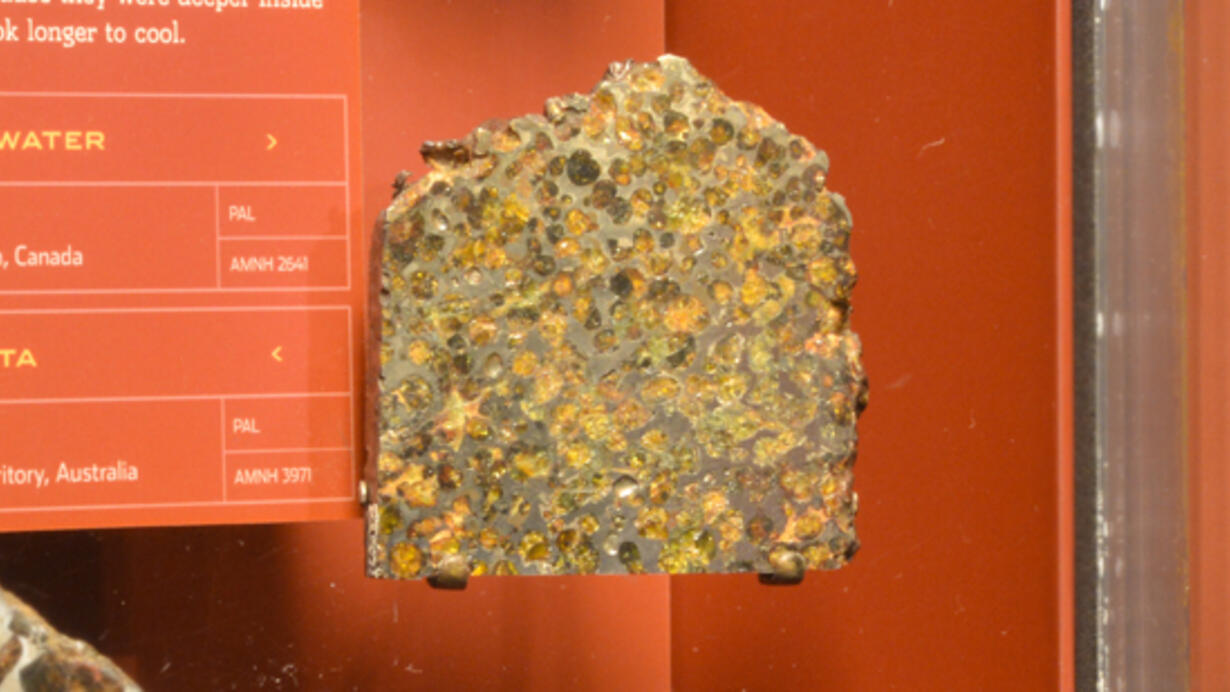Mantle
Part of Hall of Meteorites.

Why the Strange Mixture?
When newly formed planetary bodies heat and melt, iron and rock-forming minerals separate into a core and mantle. These materials separate like oil and water. So why is iron mixed with the silicate mineral olivine in these stony-iron meteorites?
Perhaps chunks of an olivine mantle fell into an outer core, where churning molten metal tore them apart. Or perhaps the iron and olivine never completely separated. No one really knows. But whatever caused the mixing, the stony-iron meteorites known as pallasites provide a snapshot of this dynamic process at the moment when the mixture solidified.
Where Are the “Missing” Olivine Meteorites?
Why have no meteorites been found from an asteroid's olivine mantle? Here are a few theories:
Theory 1: No pieces of an asteroid mantle happened to land on Earth. But considering that thousands of meteorites provide numerous samples of crusts and cores, it is hard to explain why not one single piece of mantle would have reached us.
Theory 2: After pieces of the crust were knocked off, the olivine mantles eroded away, pounded into dust by numerous collisions over billions of years. But other meteorites made of material just as fragile as olivine have managed to reach Earth.
Theory 3: A thick layer of olivine simply does not exist inside asteroids. Perhaps the olivine in differentiated asteroids did not fully separate from the crust. Or perhaps metal from the core remained mixed with olivine, and the bulk of the mantle is composed of the mixture found in pallasites.
This mystery is likely to remain unsolved until a spacecraft lands on an asteroid and analyzes its interior.
In This Section

Brenham (AMNH 879)
Gems From Space
Pallasites, with their combination of gleaming metal and translucent olivine crystals, are among the most rare and beautiful of all meteorites. Less than one percent of all known meteorites are pallasites.
BRENHAM
Found 1882
Kiowa County, Kansas, USA
PAL
AMNH 879

Dora
DORA
Found 1955 Roosevelt County, New Mexico,
USA PAL
AMNH 4440

Springwater
Round Versus Angular Crystals
Most pallasites, including Springwater, have rounded olivine crystals. But in Huckitta, the olivine crystals are much more angular. Both mixtures originated when molten iron was forced between olivine crystals in a partially melted asteroid. The rounded crystals formed when angular crystals partially melted and recrystallized — perhaps because they were deeper inside and thus took longer to cool.
SPRINGWATER
Found 1931 Saskatchewan, Canada
PAL
AMNH 2641

Huckitta
HUCKITTA
Found 1924 Northern Territory, Australia
PAL
AMNH 3971

Imilac (AMNH 2606)
IMILAC
Found 1822 Atacama Desert, Atacama, Chile
PAL
AMNH 2606

Esquel
Look Closely
Esquel shows liquid metal surging into and breaking apart a cluster of silicate crystals. These dazzling crystals are made of olivine, a mineral type that includes the gemstone peridot.
ESQUEL
Found 1951 Chubut, Argentina
PAL
AMNH 4958

Imilac (AMNH 997)
IMILAC
Found 1822
Atacama Desert, Atacama, Chile
PAL
AMNH 997

Mincy
A Misleading Mixture
Mincy resembles the other meteorites in this case because it is a mixture of stone and iron. But it is actually a mesosiderite, a completely different kind of meteorite. Unlike pallasites, which come from a region near the core, mesosiderites are a mixture of iron from the core and rock from the crust. These materials cooled at very different rates and thus could not have hardened together, so they likely were mixed by a powerful impact.
MINCY
Found 1857 Taney County, Missouri, USA
MES
AMNH 887

Albin
ALBIN
Found 1949 Laramie County, Wyoming, USA
PAL
AMNH 4373